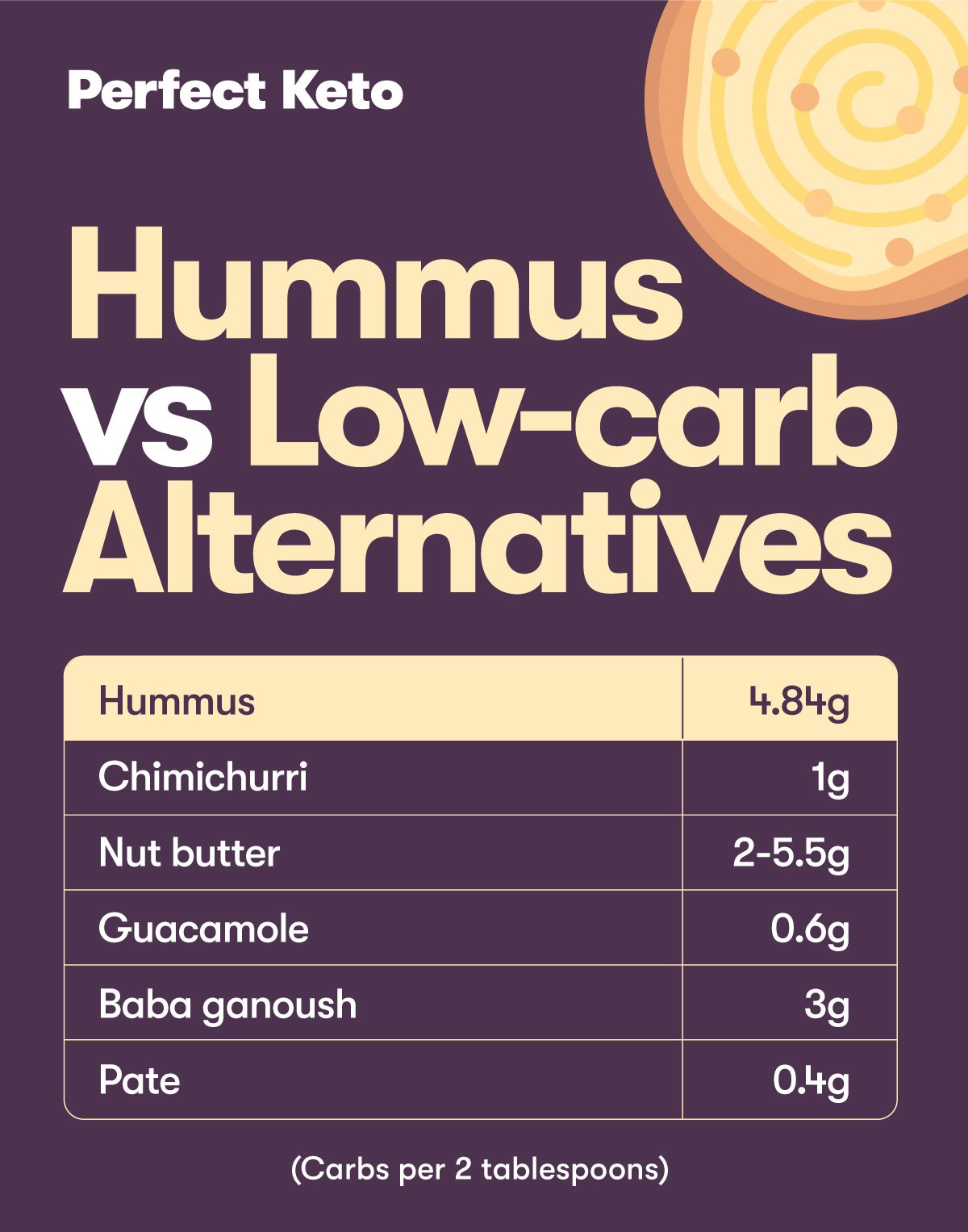Hummus has gained widespread popularity due to its delicious taste and versatility. However, as the keto diet gains traction, many wonder if this protein-packed dip can fit into their low-carb lifestyle. In this article, we answer the question, is hummus keto? Additionally, we suggest a few alternatives for those seeking a low-carb option.
Is Hummus Keto-Friendly?
Hummus is not very keto-friendly as it is high in carbohydrates due to the chickpeas. However, with some planning, hummus lovers can still enjoy the delicious dip on a keto.
Hummus is a savory dip originating from the Middle East primarily made from chickpeas, tahini (ground sesame seeds), olive oil, lemon juice, garlic, and various spices like cumin and paprika. This flavorful and versatile dip has gained global popularity and is often used as a spread, topping, or side dish.
The main ingredient in hummus, chickpeas, is relatively high in carbohydrates and dietary fiber. A 100-gram serving of cooked chickpeas has around 27 grams of carbohydrates, of which 8 grams are dietary fiber, resulting in 19 grams of net carbs (*). When combined with other ingredients, hummus itself contains a moderate amount of carbs and fats, which makes it less than ideal for strict keto diets but not entirely off-limits.
In addition to its macronutrient profile, hummus is also a good source of various micronutrients (*). It contains iron, which is essential for oxygen transportation and the production of red blood cells; vitamin B6, which plays a vital role in brain function and the synthesis of neurotransmitters; and manganese, an essential trace mineral that supports bone health and antioxidant function (* , *).
How Many Carbs Does Hummus Have?
The USDA states that 1 tablespoon of homemade hummus contains 2.42 grams of net carbs, though this number may vary based on the recipe and added ingredients (*). For instance, dessert hummus often includes sweeteners and high-carb components, rendering it unsuitable for a keto diet.
Similarly, store-bought hummus varieties usually contain a moderate amount of carbohydrates, making them just as keto-friendly. Keep in mind that hummus made with alternative ingredients, such as black soybeans or cauliflower, may have a different carb count. To ensure a keto-compatible hummus, it’s crucial to check nutritional labels or make your own at home.
Can I Eat Hummus on Keto?
You can have hummus on a keto diet, but with certain conditions. First, it’s crucial to exercise portion control, limiting hummus consumption to 3 tablespoons and being mindful of measurements to avoid overestimating serving sizes. Overindulging in hummus can lead to a higher carb intake, making it difficult to maintain ketosis.
Second, pairing hummus with keto-friendly snacks like cucumber slices, celery sticks, raw bell peppers, or low-carb crackers helps keep the overall carb count low. It’s best to avoid high-carb foods such as pita bread or chips when enjoying hummus.
Finally, whether or not hummus fits into a keto diet largely depends on your daily carb allowance. Those with stricter carb limits may benefit from exploring low-carb hummus alternatives made with cauliflower or black soybeans.
Creating keto hummus is relatively simple: replace chickpeas with steamed cauliflower or cooked black soybeans while maintaining the traditional hummus ingredients like tahini, olive oil, lemon juice, garlic, and spices.
By making this substitution, you significantly reduce the carbohydrate content while preserving the creamy texture and rich flavor of classic hummus. Additionally, using cauliflower or black soybeans introduces new nutrients to the dish, making it a nutritious and keto-friendly option for those adhering to a low-carb lifestyle.
Enjoy this homemade keto hummus with a variety of keto-friendly dippers, such as cucumber slices, celery sticks, or low-carb crackers, for a satisfying and guilt-free snack or appetizer.
Keto-Friendly Hummus Alternatives
If you’re following a keto diet and looking for hummus alternatives that are low in carbohydrates, there are a few options you can consider.
- Chimichurri: Chimichurri is a flavorful Argentinian sauce made with parsley, garlic, vinegar, and oil. To make chimichurri, combine finely chopped parsley, minced garlic, red pepper flakes, oregano, red wine vinegar, and olive oil in a bowl. Adjust salt and pepper to taste. Two tablespoons contain roughly 1 gram of net carbs, 14 grams of fat, and 0.5 grams of fiber. Enjoy it drizzled over grilled meats or vegetables as an antioxidant-rich, low-carb alternative to hummus.
- Nut butter: Compared to hummus, nut butters, such as almond, walnut, and peanut butter, are lower in carbs, with 2-5.5 grams of net carbs, 16-21 grams of fat, and 3-4 grams of fiber per 2 tablespoons (* , *). To make your nut butter, simply blend roasted almonds or macadamia nuts in a food processor until smooth, adding a pinch of salt and optional sweeteners like stevia or erythritol. Spread your homemade nut butter on keto-friendly crackers or celery for a satisfying, low-carb snack.
- Guacamole: Made from avocados, tomatoes, onions, and lime juice, guacamole is packed with several nutrients. To prepare guacamole, mash ripe avocados in a bowl and mix in finely chopped tomatoes, onions, minced garlic, cilantro, lime juice, and salt to taste. Two tablespoons contain approximately 0.6 grams of net carbs, 4 grams of fat, and 1.8 grams of fiber (*). Pair your homemade guacamole with keto-friendly chips or vegetables for a tasty, low-carb dip.
- Baba ganoush: A smoky eggplant-based dip, baba ganoush has around 3 grams of net carbs, 5 grams of fat, and 2 grams of fiber per 2 tablespoons (*). To make baba ganoush, roast a whole eggplant until tender, then scoop out the flesh and blend it with tahini, lemon juice, garlic, olive oil, and spices like cumin and paprika.
- Pate: A rich, spreadable mixture of cooked meats and fats, pate typically contains minimal carbs and offers a high-fat option for keto dieters. To prepare pate, cook liver (usually chicken or pork) and onions in butter, then blend with additional butter, heavy cream, and seasonings like thyme, salt, and pepper until smooth. Two tablespoons of pate contain roughly 0.4 gram of net carbs, 7.2 grams of fat, and 0 grams of fiber (*). Spread your homemade pate on keto-friendly bread or crackers for a delicious, low-carb treat.

The Bottom Line
While you can enjoy hummus in moderation on a keto diet, it’s essential to monitor portion sizes and pair it with keto-friendly foods. If you have stricter carb allowances or are seeking low-carb alternatives, try one of the keto-friendly hummus substitutes mentioned above. In summary, hummus can fit into a keto diet with careful planning and attention to portion control, but there are also numerous delicious, low-carb alternatives available to satisfy your cravings.
